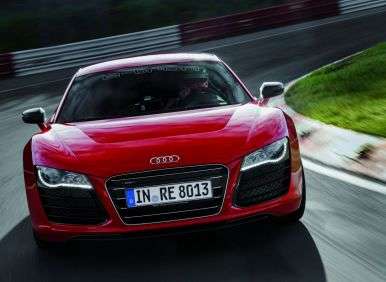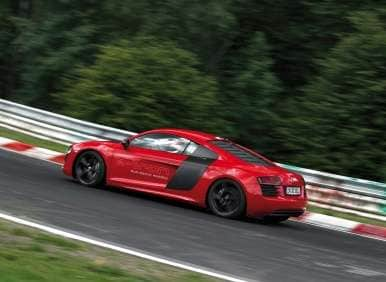Recent Articles
Popular Makes
Body Types
Audi R8 e-tron Does the ’Ring Thing in Record Time
Electric Audi Sets New Nürburgring Benchmark for Production EVs

The Audi R8 e-tron has just put the “green” back into the Green Hell: The all-electric version of Audi’s R8 sports car recently clocked a record-setting time of 8:09.099 minutes at Germany’s Nürburgring racetrack, which had earned its comparison to a more verdant underworld from F1 legend Jackie Stewart back in the 1960s. And while the exact configuration of the circuit has changed since Sir Jackie was winning Formula 1 titles back in the day, it remains the world’s most visible stage for automakers out to prove their mettle—and their metal.
“The R8 e-tron has given a magnificent demonstration of its potential on the toughest race track in the world,” said Michael Dick, AUDI AG board member for Technical Development. “The record-setting drive confirmed that we are on the right track. To us, electric mobility has never been about sacrifice, but rather is about emotion, sportiness and driving pleasure.”
Backing up that claim, the benchmark-breaking R8 e-tron relied on the same powertrain that will be used in production models when they arrive in the U.S. later this year. The only difference was that, for the record lap, Audi raised the car’s electronically governed top speed from about 124 mph to 155 mph. On the other hand, right after rewriting the EV record book, driver Markus Winkelhock ran the circuit in a production-spec car in 8:26.096—also well under the previous mark for electric vehicles.
“The record drives were a fantastic experience for me,” said Winkelhock, who co-piloted an R8 racer to victory in this year’s 24 Hours of Nürburgring competition. “Of course, the R8 e-tron is a production car, not a racing car with the assistance of aerodynamics. But with its low center of gravity and rear biased weight distribution, it brings with it a lot of sporty qualities. The torque with which the electric motors propel the car uphill beats everything that I know—even if they make hardly any noise in the process, which at the start was really a completely new experience for me. In places where I really need traction, the torque vectoring—the displacement of the torque between the powered wheels—really helps me.”
Audi R8 e-tron: Parsing the Powertrain
Except for its terminal velocity, the fastest EV ever to take on the Nürburgring relied on a “drive system … [that] corresponds in every detail with that of the production model,” so let’s take a quick look at those details.
The heart of the matter is a T-shaped lithium-ion battery pack that can store up to 49 kWh of electricity and has been configured to fit between the cabin and the rear axle, maintaining the R8’s “mid-engined” layout. This enables both a low center of gravity and an optimum distribution of weight, although there isn’t much of the latter, relatively speaking. Thanks to plenty of aluminum and carbon fiber, the R8 e-tron will weigh a bit over 3,900 lbs. True, that is more than 300 lbs. heavier than the R8 when driven by its standard 4.2-liter V8, but the two cars actually sprint from 0 to 100 kilometers per hour in the same amount of time: 4.6 seconds. That’s because, according to Audi, the R8 e-tron’s two “electric motors generate an output of 280 kW [375 hp] and 820 Nm [604 lb.-ft.] of torque; more than 4,900 Nm (3,614.05 lb-ft) are distributed to the rear wheels nearly from a standing start.”
But here’s the real kicker: While the R8 4.2 only posts an EPA line of 13 mpg city/21 mpg highway/16 mpg combined—with premium fuel—the R8 e-tron is expected to deliver an all-electric, zero-emissions driving range of about 133 miles, with a typical EV-recharging time of 6-8 hours.
Which actually sounds more like green heaven.
